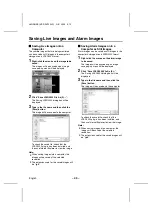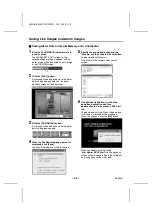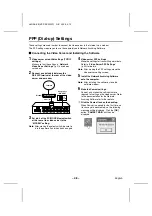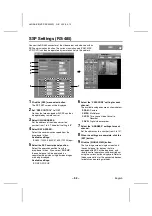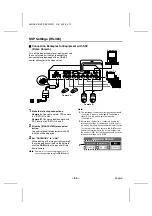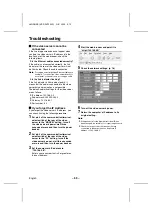
PPP (Dial-up) Settings
These settings are used in order to connect the video server to the Internet via a modem.
The PPP settings require you to use the separately-sold Network Archiving Software.
Connecting the Video Server and Installing the Software
1
Video server wired LAN settings (TCP/IP
settings)
Make sure that the settings in “Network
Video Server Settings” (p. 9) have been
carried out.
2
Connect a serial cable between the
RS-232C terminal at the rear of the video
server and a modem.
3
Set pin 2 of the PC/MODEM select switch
at the rear of the video server to the
“MODEM” setting.
Note: After moving the select switch, be sure to
turn the power off and then back on again.
4
Video server PPP settings
Make the settings for transmitting alarm data.
Refer to “Video Server PPP Settings”
(p. 50) for details.
Note: After making the PPP settings, close the
video server setting screen.
5
Install the Network Archiving Software
onto the computer.
Note: After installing the software, close the
software window.
6
Make the Camset settings.
Camset only makes the settings that are
required for setting up the video server. Refer
to the documentation for the Network
Archiving Software for further details.
1
Click the Camset icon on the desktop.
When Camset is opened for the first time, no
files have yet been created, so the following
message will be displayed. Click the [OK]
button. “CAMSET MAIN” will then be
displayed.
Internet
Serial cable
Set pin 2 to
“MODEM”
Modem
GND
12VDC
IN
OUT
VIDEO 1
IN
OUT
VIDEO 2
IN
A
1
2
3
4
RS-232C
COM
COM
ALARM
OUT
ALARM
IN
RS485
TERMI
ON
MODEM
ETHERNET
ALL RESET
PC
B A B
OUT
VIDEO 3
IN
OUT
VIDEO 4
1 2
MODEM
PC
1 2
L8NAA/XE
(VSP-SV2000P) GB 2003,
5,
12
– 48 –
English










